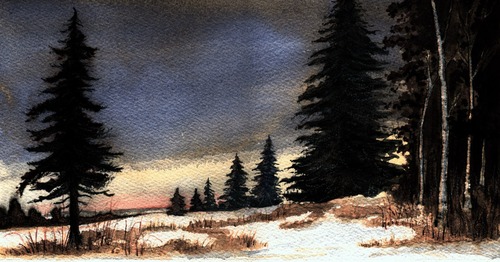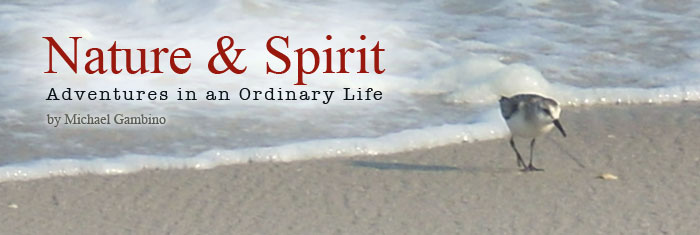Winterlude
 Tuesday, January 4, 2011 at 12:05AM
Tuesday, January 4, 2011 at 12:05AM  Watercolor illustration © Michael GambinoDarkness descends early on these winter days, and as such, I find it a challenge to make time for daylight hikes. But I am comfortable in the night woods, so I begin my hike tonight just as the stars come out. My thoughts shift from the day’s to-do list to the elusive whisperings of the primal mind.
Watercolor illustration © Michael GambinoDarkness descends early on these winter days, and as such, I find it a challenge to make time for daylight hikes. But I am comfortable in the night woods, so I begin my hike tonight just as the stars come out. My thoughts shift from the day’s to-do list to the elusive whisperings of the primal mind.
The stars appear as jewels gently sprinkled upon the blue veil of night. Yet out there, in the incredibly vast, cold darkness of space, massive spheres of exploding gas hurl their light-energy violently across space and time. As I walk, I contemplate the odds that one such star should have ended up in just the right proximity to our planet – giving it life rather than death. In this, I find hope.
After a while I stop to rest on a log. These night hikes are meditations, a chance to quiet my mind and expand my senses. Winter, especially in the cold northeast, is a time of rest for nature. Conservation of energy is the number one law to which all nature adheres — except humans, of course. We attempt to override millions of years of evolution to maintain the same hectic pace day after day, regardless of our health, weather, available resources, hurricanes, volcanic eruptions, killer asteroids, etc. Living in modern society seems to have corrupted the original instructions in our brain’s limbic system. Our distant (and not so distant) ancestors had many things to do as well, but their earth-living skills included – indeed depended on – family participation. Mr. and Mrs. Cro-Magnon and their children didn’t leave the cave each morning, scattering in all directions to earn a living or get a diploma. They traveled and worked at things together. Most of us spend more time with other “families” than with our own. Over time, we have replaced our homesteading skills with the dollar. In fact, we have to put in so much effort to get enough money to pay for the shelter we don’t build, the food we don’t grow or hunt, the clothing and tools we no longer know how to make, that we have little time for the relationships that truly matter to us and make us whole. This is one of the hidden costs of our modern convenience lifestyle.
Nearby where I have rested on the log, an abandoned paper wasp nest is suspended from a branch. This nest was built in one summer by the vigorous efforts of the wasps. Where are they now? Dead. Wasp colonies die once their purpose is fulfilled. There is no sustenance for them in the frozen meadows of winter. Only the young queens hibernate to start new colonies in the spring. Conservation of energy and the availability of resources dictate that some species hibernate, migrate, or die. Woodchucks sleep through the winter, while Ruby-throated Hummingbirds head for the warmth and nectar of Costa Rica. Others, like the deer and coyote can tough it out. There are many unique strategies for the survival of the species, be it animal or plant.
A gust of cold wind brings a flurry of snow, and inspires me to resume my walking. The wind shakes the plant skeletons and tears at oak leaves that still won’t let go of their branches. The rattling, buzzing sound accentuates the silence of the night. Looking around I see the pale, dried flowers of the once vibrant yellow goldenrod. I notice the round and elliptical bulges on the stems of some. These plants still have life in them, but it is of an animal nature now. Housed inside these galls are moth or fly larvae waiting for the warmth of spring. Certain caterpillars and flies cause the plant to deform into these shapes making perfect winter shelters for the developing larva. How nice and cozy! Then I recall that certain species of Ichneumon wasps are somehow aware of what’s inside these galls. Before the winter arrives, they deposit their eggs inside these galls with their long, drill-like ovipositor. The wasp larva will hatch and feast on the pupating moth inside, make its own cocoon, and emerge in late summer. I shook my head. Impressed as I was at this adaptation in nature, I was still dismayed that there was no escaping this eat-and-be-eaten reality of life. I mean, I wouldn’t like it much if I were all snug and warm in my bed, only to find a giant, pale-white larval wasp in the room, eyeing me while snapping its mandibles in my direction.
Anyway, wishing to get that image out of my mind, I shifted my attention to the delicate crashing sound of snowflakes against plants that have refused to lie down even in death. There was Dogbane, Queen Anne’s Lace, Common Milkweed, Steeplebush, Mountain Mint, Common Mullein, and White Vervain, among others, wrapped now in the blue-black cloak of night, they shudder, creak, snap, rattle, groan, hiss, crack, and squeak at the touch of wind and snow: they are the vocal chords of the wind.
Continuing my walk, I enter the hardwood forest that has dropped its leafy canopy. Here, all things look to be abandoned or asleep. Yet those fallen leaves lying beneath the falling snow provide insulation, protection, and food for countless creatures – those macro- and microorganisms of the soil ecosystem. The activities of soil animals are essential to the forest and help to create new soil. Some will eat debris, while others hide in microscopic caves and pounce on unsuspecting bacteria. Nematodes or roundworms feed on plant roots and fungi, and in turn are snared by fungi and consumed. From bacteria to beetles, all soil animals help break apart the chemical bonds of organic matter, making chemicals and minerals available for trees, shrubs, and herbaceous plants, as well as other soil animals. All this microscopic drama takes place under each footprint I leave tonight. I walk on with respect, knowing that without these creatures doing their work at the very bottom of the food chain, forests would disappear, crops would fail, and we would ultimately starve to death.
A break in the forest canopy silhouettes a Shagbark Hickory tree against the sky. Its shaggy-looking bark plates offer numerous places for insects to overwinter. Wedged into bark crevices, insects hope to survive the long winter, while nuthatches, titmice, woodpeckers, chickadees, and wrens hope to find them.
In my mind’s eye I can see chipmunks and woodchucks peacefully dreaming their winter dreams below the surface, out of reach of the freezing fingers of winter as they await the spring.
Deeper into the woods I wander, passing stone walls that offer shelter for snakes, mice, and still other insects. Mice are active throughout the winter, their tracks often seen on the snow, running here and there. The mice, along with Meadow Voles, and the Short-tailed Shrew, tunnel under the insulating snow, nibbling tender shoots of plants and munching unclaimed seeds and hapless beetle larvae. Further on, I find turkey tracks where they have scratched away the layers of snow and leaves in search of acorns and hickory nuts overlooked by Gray Squirrels.
Looking at all the plant life around me from the tall grasses to the towering Tulip trees, I began to perceive a great consciousness deep in the earth amongst the plant roots. My awareness is drawn into the soil now. In my mind’s eye, I see an utterly dark place of rock, root, and seed. I perceive things, understand things in the subterranean world of the forest and meadow that are impossible to describe. The plants have gathered their energies back into their roots as they wait for spring. Contained in these roots and seeds the fresh, bright-green spring lies sleeping while winter governs the world above.
My attention is brought back to the surface again as a deer passes a few yards away from where I stand. The hour is getting late, so I pick up my pace, heading towards a majestic oak tree nearby.
The power in that tree, even in the silence of winter darkness, is palpable. I think of how many winters this tree has endured, and what an incredible vault of knowledge it must have. Through hundreds of winters, this oak has witnessed the comings and goings of fox, rabbit, woodchuck, mice, deer, squirrel, birds, and insects. If this tree could talk it would tell a fascinating tale of years! (Or perhaps more correctly, if my ears could decipher the conversations of trees). Tonight, though, I can only guess at what it knows.
A large cluster of snowflakes shatters upon my nose, startling me, causing me to realize that it is time to head home with a collection of questions answered and questions raised. The whispering conversation between the landscape and the human heart can’t easily be translated because it is a language without words. Not all questions are meant to have answers, but instead lead us to something more important.

Reader Comments (2)
You continue to amaze me with your ability to see beneath the surface of such beauty.
You make me stop and think many, many thoughts.
You speak of "a language without words," and yet you have managed to find the perfect words to interpret this silent language. Bravo!
The rhythm of the woods at night, with its unseen activity and barely-heard sounds, has much to teach us: all that is essential is often invisible to the eye and ear. But if we listen with the heart, as you do, we find a wealth of information. Thank you for the poetry of your soul.